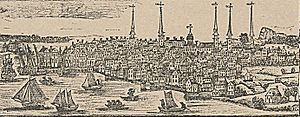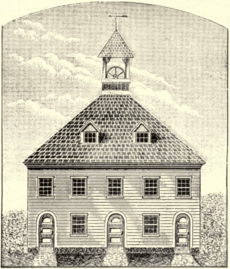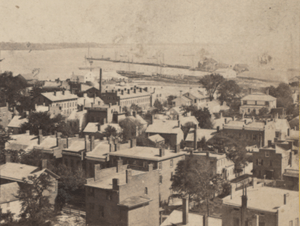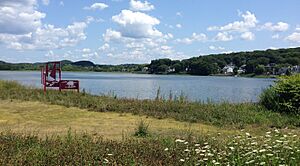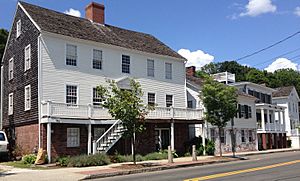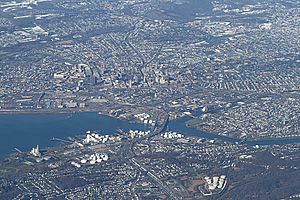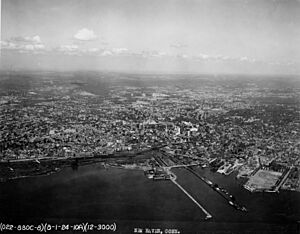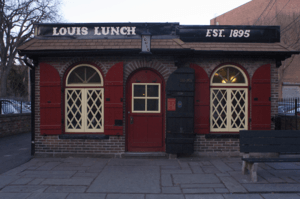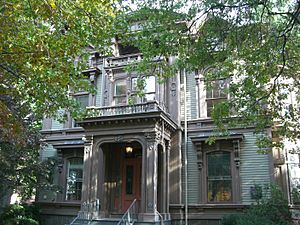New Haven, Connecticut facts for kids
Quick facts for kids
New Haven
|
|||||
|---|---|---|---|---|---|
|
From top, left to right: Downtown, East Rock Park, New Haven Green, Upper State Street Historic District, Five Mile Point Lighthouse, Harkness Tower, and Connecticut Hall at Yale University
|
|||||
|
|||||
| Nickname(s):
The Elm City
|
|||||
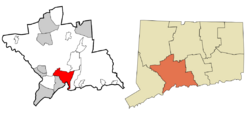 New Haven County and Connecticut New Haven County and Connecticut |
|||||
| Country | United States | ||||
| U.S. state | Connecticut | ||||
| County | New Haven | ||||
| Region | South Central CT | ||||
| MSA | Greater New Haven | ||||
| CSA | New Haven-Hartford-Waterbury | ||||
| Settled (town) | April 3, 1638 | ||||
| Incorporated (city) | 1784 | ||||
| Consolidated | 1895 | ||||
| Named for | A "New Haven", meaning "new harbor" | ||||
| Government | |||||
| • Type | Mayor–board of aldermen | ||||
| Area | |||||
| • City | 20.13 sq mi (52.15 km2) | ||||
| • Land | 18.69 sq mi (48.41 km2) | ||||
| • Water | 1.44 sq mi (3.74 km2) | ||||
| Elevation | 59 ft (18 m) | ||||
| Population
(2020)
|
|||||
| • City | 135,081 | ||||
| • Density | 7,170/sq mi (2,768.5/km2) | ||||
| • Urban | 561,456 (US: 77th) | ||||
| • Urban density | 1,884.0/sq mi (727.4/km2) | ||||
| • Metro | 862,477 (US: 69th) | ||||
| Demonym(s) | New Havener | ||||
| Time zone | UTC−5 (Eastern) | ||||
| • Summer (DST) | UTC−4 (Eastern) | ||||
| ZIP Codes |
06501–06540
|
||||
| Area code(s) | 203/475 | ||||
| FIPS code | 09-52000 | ||||
| GNIS feature ID | 0209231 | ||||
| Airport | Tweed New Haven Airport | ||||
| Major highways | |||||
| Commuter rail | |||||
New Haven is a city in New Haven County, Connecticut, United States. It is located on New Haven Harbor by the Long Island Sound. With about 135,000 people, New Haven is the third largest city in Connecticut. It is also the main city in the Greater New Haven area, which has over 860,000 people.
New Haven was one of the first planned cities in the U.S. In 1639, a year after it was founded, eight streets were laid out in a grid pattern. This created the "Nine Square Plan." The center block, called the New Haven Green, is a 16-acre square in Downtown New Haven. The Green is now a National Historic Landmark. The "Nine Square Plan" is recognized as a National Planning Landmark.
New Haven is home to Yale University, which is the city's largest employer and taxpayer. Health care, financial services, and shops also help the city's economy.
From 1701 to 1873, New Haven was a co-capital of Connecticut. Then, Hartford became the only capital. New Haven calls itself the "Cultural Capital of Connecticut" because it has many theaters, museums, and music places. New Haven was also the first U.S. city to have a public tree planting program. This created many large elm trees, giving the city its nickname, "The Elm City."
Contents
History of New Haven
Early Days and Founding
Before Europeans came, the Quinnipiac tribe of Native Americans lived in the New Haven area. They had villages around the harbor and fished and farmed maize. A Dutch explorer, Adriaen Block, visited briefly in 1614. Dutch traders exchanged beaver pelts with the locals, but they did not settle there.
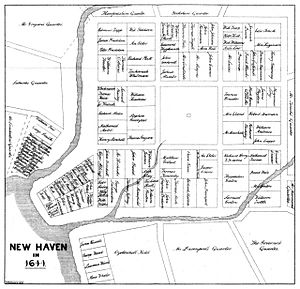
In 1637, a small group of Puritans explored the New Haven harbor. In April 1638, about 500 Puritans arrived. They had left the Massachusetts Bay Colony and were led by Reverend John Davenport and merchant Theophilus Eaton. They wanted to create a religious community and use the area as a port. The Quinnipiacs, who were being attacked by the Pequots, sold their land to the settlers for protection.
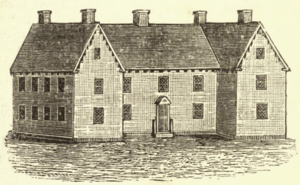
By 1640, the town had a religious government and its nine-square grid plan. It was renamed New Haven, meaning "new harbor." The area to the north was called Quinnipiac until 1678, when it became Hamden. New Haven became the main town of the New Haven Colony, which was separate from the Connecticut Colony in Hartford. The New Haven Colony did not allow other churches, unlike the Connecticut Colony.
In 1646, New Haven faced an economic problem. Its first ship full of local goods, called the "Great Shippe," was sent to England but never arrived. This slowed New Haven's growth compared to other trading cities like Boston and New Amsterdam (now New York).
In 1660, the Hopkins School was founded in New Haven. This fulfilled a wish of founder John Davenport.
In 1661, two men who had signed the death warrant for Charles I of England, Colonel Edward Whalley and Colonel William Goffe, fled to New Haven. Charles II was hunting them. Davenport helped them hide in the West Rock hills. A third judge, John Dixwell, joined them later. None of them were ever sent back to England.
Becoming Part of Connecticut
In 1664, New Haven became part of the Connecticut Colony. This happened because of pressure from England. Some members of the New Haven Colony moved away to start a new religious community in Newark, New Jersey.
New Haven became a co-capital of Connecticut in 1701. It remained a capital until 1873.
In 1716, the Collegiate School moved from Old Saybrook to New Haven. This made New Haven a center for learning. In 1718, the school was renamed Yale College after Elihu Yale gave a large donation.
New Haven citizens fought alongside British forces in wars like the French and Indian War. As the American Revolution began, some leaders hoped to avoid a full rebellion. On April 23, 1775, Captain Benedict Arnold led New Haven's militia to get weapons for a march to Cambridge, Massachusetts. This event is still celebrated as Powder House Day.
On July 5, 1779, British soldiers and loyalists attacked New Haven. A militia of Yale students prepared to fight. New Haven was not burned like other towns, so many of its old buildings were saved.
Growth and Industry
New Haven became a city in 1784. Roger Sherman, who signed the Constitution, became its first mayor.
The city grew thanks to Eli Whitney, a Yale graduate. He invented the cotton gin and started a gun factory in the northern part of the city. This area is still called Whitneyville. His factory, along with others, helped Connecticut become a strong manufacturing state, known as "The Arsenal of America." Samuel Colt invented the automatic revolver at Whitney's factory in 1836. Other inventors like Oliver Winchester also started firearms companies in New Haven.
The Farmington Canal was built in the early 1800s to transport goods. It ran from New Haven to Northampton, Massachusetts.
New Haven played a role in the anti-slavery movement. In 1839, the trial of Mende tribesmen from the Spanish slave ship Amistad was held in New Haven. There is a statue of Joseph Cinqué, the leader of the slaves, near City Hall. Abraham Lincoln gave a speech about slavery in New Haven in 1860.
The American Civil War helped the local economy by increasing demand for industrial goods. After the war, New Haven's population grew, especially with immigrants from southern Europe, like Italy. Today, many people in nearby towns like East Haven are Italian-American.
Modern New Haven
New Haven continued to grow during the World Wars. Many African Americans from the American South and Puerto Ricans moved to the city. After World War II, the city's population reached its highest point. As in other U.S. cities, many middle-class families moved to the suburbs.
In 1954, Mayor Richard C. Lee started major urban renewal projects. Parts of downtown New Haven were rebuilt with museums, offices, and shops. New highways like Interstate 95 and Interstate 91 also changed the city.
Since about 2000, downtown New Haven has been revitalized. Many new restaurants, nightlife spots, and shops have opened. New apartments and condominiums have also been built. The city has seen positive changes, with new supermarkets and large residential buildings.
In 2010 and 2011, funds were given to build the Hartford Line, a train service from New Haven to Springfield. This project will improve train travel and connect more communities.
New Haven's Notable Firsts
- 1638: New Haven becomes the first planned city in America.
- 1776: Yale student David Bushnell invents the first American submarine.
- 1787: John Fitch builds the first steamboat.
- 1836: Samuel Colt invents the automatic revolver at Whitney's factory.
- 1839: Charles Goodyear discovers how to vulcanize rubber.
- 1860: Philios P. Blake patents the first corkscrew.
- 1877: New Haven hosts the first Bell telephone switch office.
- 1878–1880: The District Telephone Company of New Haven creates the world's first telephone exchange and telephone directory. It also installs the first public phone.
- 1882: The Knights of Columbus are founded in New Haven. Their world headquarters and a museum are still in the city.
- 1892: Local candy maker George C. Smith invents the first lollipops.
- Late 19th century-early 20th century: The first public tree planting program in America takes place in New Haven.
- 1900: Louis Lassen, owner of Louis' Lunch, is credited with inventing the hamburger and the steak sandwich.
- 1911: The Erector Set, a popular construction toy, is invented in New Haven by A.C. Gilbert.
- 1920: The Frisbee is said to have started on the Yale campus. Students tossed around tin pans from the Frisbie Pie Company.
- 1977: The first public memorial to victims of the Holocaust in America is built in New Haven's Edgewood Park.
Geography and Climate
City Layout and Features
New Haven covers about 20 square miles (52.1 square kilometers). About 1.4 square miles (3.7 square kilometers) of this is water.
New Haven is known for its large, shallow harbor. It also has two reddish rock ridges to the northeast and northwest. These are called East Rock and West Rock, and they are both large parks. West Rock has a tunnel for the Wilbur Cross Parkway. It was also a hiding place for the "Regicides" (three judges who signed King Charles I's death warrant). East Rock has a large war monument on its peak.
Three rivers flow through the city: the West, Mill, and Quinnipiac. They all flow into New Haven Harbor or West Haven Harbor, which are part of Long Island Sound.
Weather in New Haven
New Haven has a humid subtropical climate. This means it has hot, humid summers and cool to cold winters. From May to September, the weather is usually hot and humid. Temperatures can reach 95°F (35°C) or higher during heat waves. Thunderstorms are common in summer. Winters have changing temperatures, with both rain and snow.

New Haven has a long history of urban planning. The city was designed with a grid plan of nine square blocks when it was founded. The central square was left open as the city green. New Haven also started the first public tree planting program in America. Many of the elm trees that gave New Haven its nickname "Elm City" died from Dutch elm disease in the mid-1900s, but many have been replanted. The New Haven Green has three historic churches and is still the city's social center. It became a National Historic Landmark in 1970.
Downtown New Haven has nearly 7,000 residents. It provides about half of the city's jobs and tax money. In recent years, it has gained many new restaurants, shops, and apartments.
Neighborhoods of New Haven
New Haven has many different neighborhoods. Besides Downtown, which is around the central business district and the Green, there are:
- West central: Dixwell and Dwight.
- Southern: The Hill, City Point (or Oyster Point), and Long Wharf.
- Western: Beaver Hills, Edgewood, West River, Westville, Amity, and West Rock-Westhills.
- Northern: East Rock, Cedar Hill, Prospect Hill, and Newhallville.
- East central: Mill River and Wooster Square, an Italian-American neighborhood.
- Across the Quinnipiac River: Fair Haven, Quinnipiac Meadows and Fair Haven Heights.
- Eastern harbor: The Annex and East Shore (or Morris Cove).
People of New Haven
Population Information
New Haven's population was 135,081 in 2020. The city has a mix of different groups of people. In 2010, about 42.6% of residents were White, 35.4% were African American, and 4.6% were Asian. About 27.4% of the population was Hispanic or Latino. The city's Latino population is growing quickly.
The median age in New Haven was 29 years old in 2010, which is younger than the national average. About 24.4% of the population lived below the poverty line.
New Haven is known for having a high percentage of Italian American residents. It is also famous for its unique local style of pizza.
Economy
New Haven's economy used to be based on manufacturing. But after World War II, many factories closed. Today, more than half (56%) of the city's economy comes from services, especially education and health care. Yale University is the city's biggest employer, followed by Yale – New Haven Hospital. Other large employers include Southern Connecticut State University, Assa Abloy (lock manufacturing), and the Knights of Columbus headquarters.
In 2017, New Haven was ranked as one of the top 10 cities in America for starting new technology companies.
Main Industries: Services (55.9%), Trade (21.7%), Finance and Real Estate (7.1%), Construction and Mining (4.9%), Government (4.0%), Transportation and Utilities (2.9%), Manufacturing (2.9%), Agriculture (.6%).
Major Companies and Organizations
The Knights of Columbus, the world's largest Catholic service group, has its main office in New Haven. Amphenol, a large company, is based nearby in Wallingford. Several other companies traded on stock exchanges are based in New Haven, including NewAlliance Bank and United Illuminating. The American part of Assa Abloy (a leading lock maker) is also in the city. The Southern New England Telephone Company (SNET) started in New Haven in 1878 and is still based there.
Education
Colleges and Universities
New Haven is a major center for higher education. Yale University is in the heart of downtown and is very important to the city. New Haven is also home to Southern Connecticut State University and Albertus Magnus College. Gateway Community College has a campus downtown.
Just outside New Haven, you can find Quinnipiac University and the Paier College of Art in Hamden. The University of New Haven is in nearby West Haven.
Schools for Kids
New Haven Public Schools is the school district for the city. Wilbur Cross High School and Hillhouse High School are the two largest public high schools.
Hopkins School, a private school, was founded in 1660. It is the fifth-oldest school in the United States. New Haven also has many other private schools and public magnet schools. These include Metropolitan Business Academy, Hill Regional Career High School, and the Sound School. These schools welcome students from New Haven and nearby towns.
Culture and Fun
Food in New Haven
New Haven was named the Best Foodie City in the country in 2014. There are many highly-rated restaurants in the city, offering a wide variety of foods. You can find Malaysian, Ethiopian, Spanish, French, Greek, Mexican, Italian, Thai, Chinese, Japanese, and many other cuisines.
New Haven is most famous for its pizza, called "apizza." It is said to be among the best in the world. Apizza started at Frank Pepe Pizzeria Napoletana (Pepe's) in 1925. It is baked in coal or wood-fired ovens and has a thin crust. You can order red (with tomato sauce) or white (with garlic and olive oil). A white clam pie is a special dish at restaurants on Wooster Street, like Pepe's and Sally's Apizza. Modern Apizza on State Street is also very popular.
Another famous food spot is Louis' Lunch, which has been serving food since 1895. The Library of Congress credits its founder, Louis Lassen, with inventing the hamburger and steak sandwich. Louis' Lunch cooks hamburgers and steak sandwiches vertically in old cast iron stoves.
Miya's is another unique restaurant in New Haven. It was the world's first sustainable sushi restaurant. Miya's chef, Bun Lai, is known for using sustainable seafood and even invasive species in his sushi.
During weekdays, over 150 lunch carts and food trucks serve diners around the city. They gather in a few main spots, like on Long Wharf Drive and near Yale – New Haven Hospital.
Farmers' markets, run by CitySeed, are held weekly in several neighborhoods. The Elm City Market, a large grocery store, opened in 2011 and sells local produce.
Arts and Entertainment
Theatres and Movies
New Haven has many theaters, including the Yale Repertory Theatre, the Long Wharf Theatre, and the Shubert Theatre. The Yale School of Drama also puts on plays. Southern Connecticut State University has the Lyman Center for the Performing Arts. The old Palace Theatre was renovated and reopened as the College Street Music Hall in 2015.
The Shubert Theatre used to host many major plays before they went to Broadway. Famous shows like Oklahoma!, My Fair Lady, and The Sound of Music premiered there.
Bow Tie Cinemas operates the Criterion Cinemas, a modern movie theater with seven screens. It opened in 2004 and shows both popular and independent films.
Museums to Explore
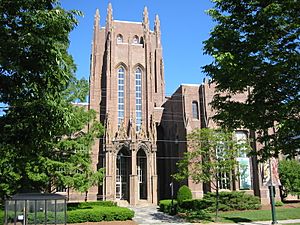
New Haven has many museums, often connected to Yale. The Beinecke Rare Book and Manuscript Library has an original copy of the Gutenberg Bible. Other museums include:
- The Connecticut Children's Museum.
- The Knights of Columbus museum.
- The Peabody Museum of Natural History.
- The Yale University Collection of Musical Instruments.
- The Eli Whitney Museum (just outside the city in Hamden).
- The Yale Center for British Art, which has the largest collection of British art outside the U.K.
- The Yale University Art Gallery, the oldest college art museum in the Western Hemisphere.
- The New Haven Museum and Historical Society, with old documents and treasures.
Artspace and other galleries show contemporary art by local and international artists.
New Haven is also home to a replica of the historic Freedom Schooner Amistad. You can take tours of it at Long Wharf pier in the summer. The Quinnipiack schooner also offers sailing cruises and serves as a floating classroom.
Music Scene
The New Haven Green hosts many free music concerts, especially in the summer. These include the New Haven Symphony Orchestra and the July Free Concerts. The New Haven Jazz Festival (started in 1982) is one of the longest-running free outdoor festivals in the U.S. Famous artists like Ray Charles have performed there.
New Haven is home to the concert venue Toad's Place and the College Street Music Hall. The city also has an alternative music scene that has influenced indie and underground hip-hop.
The Yale School of Music offers many free concerts throughout the year. Large performances are held in the 2,700-seat Woolsey Hall auditorium.
Festivals and Events
Besides the Jazz Festival, New Haven hosts the annual International Festival of Arts and Ideas. New Haven's Saint Patrick's Day parade, which started in 1842, is the oldest in New England. It draws huge crowds. The St. Andrew the Apostle Italian Festival has been held in the historic Wooster Square neighborhood since 1900.
New Haven celebrates Powder House Day every April to remember the city's role in the Revolutionary War. The annual Wooster Square Cherry Blossom Festival celebrates the planting of 72 Japanese cherry blossom trees in 1973. The Film Fest New Haven has been held every year since 1995.
Nightlife and Fun
In the last ten years, downtown New Haven has gained many new restaurants, bars, and nightclubs. The Crown Street area is especially popular on weekends. Upper State Street also has many popular spots.
Media and Sports
News and Media
New Haven has a daily newspaper, the New Haven Register, and an online daily, the New Haven Independent. There are also student-run papers from Yale University. Several TV stations broadcast from New Haven, including WTNH (ABC) and WCTX (MyNetworkTV).
Sports and Teams
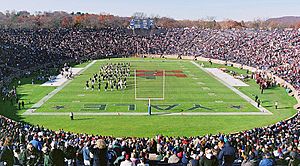
New Haven has a long history of professional sports. It has been home to baseball, basketball, football, hockey, and soccer teams. The New York Giants of the National Football League played at the Yale Bowl from 1973 to 1974.
The city hosted the 1995 Special Olympics World Summer Games. New Haven also hosts the Pilot Pen International tennis event every August at the Connecticut Tennis Center. This is one of the largest tennis venues in the world. New Haven also hosts "The Game" between Yale and Harvard every two years.
Walter Camp, known as the "father of American football," was from New Haven.
Buildings and Landmarks
Architecture in New Haven
New Haven has many famous buildings from different time periods and styles. Many architects have left their mark on the city. The Yale School of Architecture has helped this part of the city's economy. Famous architects like Frank Lloyd Wright, Louis Kahn, and Eero Saarinen have designed buildings here. Yale's Ingalls Rink, designed by Eero Saarinen, was named one of "America's Favorite Architecture" in 2007.
Many of the city's neighborhoods are well-preserved. They are like "museums" of 19th and 20th-century American architecture, especially around the New Haven Green and Hillhouse Avenue. A large part of the city is made up of historic districts.
The five tallest buildings in New Haven are:
- Connecticut Financial Center (383 feet, 26 floors)
- 360 State Street (338 feet, 32 floors)
- Knights of Columbus Building (321 feet, 23 floors)
- Kline Biology Tower (250 feet, 16 floors)
- Crown Towers (233 feet, 22 floors)
Historic Places to Visit
New Haven has many historical sites. The New Haven Green, a National Historic Landmark, was created in 1638. It has three 19th-century churches. Under the First Church of Christ, there is a 17th-century crypt that visitors can see. Famous people buried there include the first wife of Benedict Arnold. The Old Campus of Yale University is next to the Green and includes Connecticut Hall, Yale's oldest building. Hillhouse Avenue is known for its beautiful 19th-century mansions. Charles Dickens reportedly called it "the most beautiful street in America."
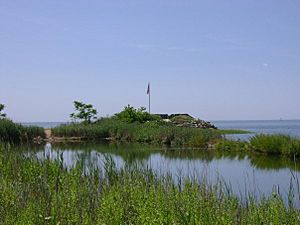
In 1660, Edward Whalley and William Goffe, two generals who signed the death warrant for King Charles I, hid in a rock formation in New Haven. They had fled England after Charles II became king. A third judge, John Dixwell, joined them later. This rock formation, now part of West Rock Park, is called Judges' Cave.
After the American Revolutionary War began in 1776, Black Rock Fort was built to protect New Haven's port. In 1779, British soldiers captured and burned it. The fort was rebuilt in 1807 and renamed Fort Nathan Hale. Its cannons helped defend the city during the War of 1812. A second Fort Hale was built in 1863 during the Civil War. All three versions of the fort have been restored and are now a popular historic site.
Grove Street Cemetery, a National Historic Landmark, is next to Yale's campus. It holds the graves of famous people like Eli Whitney and Noah Webster. It is known for its Egyptian Revival gateway and is the oldest planned burial ground in the U.S.
Lighthouse Point Park is a public beach with the Five Mile Point Lighthouse (built in 1847) and the Lighthouse Point Carousel (built in 1916). Both are listed on the National Register of Historic Places.
Other historic sites include the Soldiers and Sailors Monument on East Rock, the Marsh Botanical Garden, Wooster Square, Louis' Lunch, and the Farmington Canal.
Transportation
Trains in New Haven
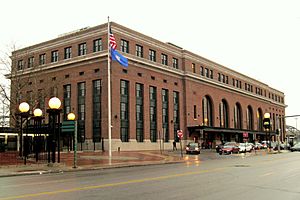
New Haven has two train stations that connect to New York City and other places.
- Metro-North Railroad's New Haven Line goes west to cities like Stamford and New York City.
- Shore Line East goes east to Old Saybrook and New London.
- Hartford Line goes north to Hartford and Springfield, Massachusetts.
- Amtrak provides regional and intercity trains to New York, Washington, D.C., Boston, and Vermont.
The main train station is the historic Union Station. About 175 trains use Union Station on weekdays. A second station, State Street Station, opened in 2002. It gives passengers easier access to downtown New Haven.
Bus Services
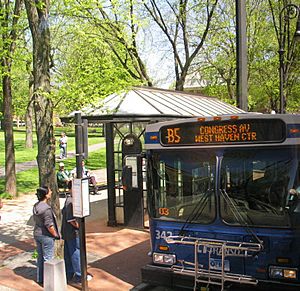
The New Haven Division is the state's bus system. It has 24 routes that start from the New Haven Green. Buses go to 19 different towns in Greater New Haven. There is also a free shuttle from Union Station to the New Haven Green.
Biking in the City
In 2018, New Haven launched its Bike New Haven bike share program. It uses dockless bikes and has many stations around the city. Yale University also has its own bike share program using the same technology.
Bike Lanes and Trails
New Haven added its first bike lane in 2004 on Orange Street. Since then, more bike lanes have been added on other streets. The city has also created recommended bike routes.
The Farmington Canal Trail is a bike path that will eventually go from downtown New Haven to Northampton, Massachusetts. A 14-mile stretch of the trail is already open, connecting New Haven to Hamden and Cheshire. This trail is part of the East Coast Greenway, a planned 3,000-mile bike path along the East Coast.
Roads and Highways

New Haven is where Interstate 95 and Interstate 91 meet. I-95 goes south to New York City and east to Rhode Island and Massachusetts. I-91 goes north into Connecticut, Massachusetts, and Vermont. The Pearl Harbor Memorial, or "Q Bridge," on I-95 often causes traffic jams.
The Wilbur Cross Parkway (Connecticut Route 15) runs parallel to I-95 and I-91. It goes through West Rock via the Heroes Tunnel, which is the only highway tunnel in Connecticut.
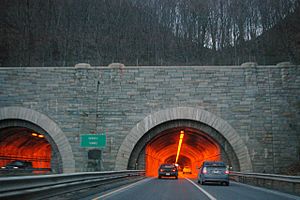
The city also has several main roads. U.S. Route 1 runs south of downtown. Whalley Avenue, Dixwell Avenue, and Whitney Avenue are major roads heading north and northwest.
Airport and Seaport
Tweed New Haven Airport is located about 3 miles east of downtown. Avelo Airlines and Breeze Airways offer flights to many cities from Tweed.
New Haven Harbor is home to the Port of New Haven, a deep-water seaport. It can handle large ships and cargo. The port has facilities to load many trucks and has large storage areas.
City Services
Hospitals and Healthcare
The New Haven area has several excellent medical facilities. The two main hospitals downtown are Yale – New Haven Hospital and the Hospital of Saint Raphael. Yale – New Haven Hospital includes the Children's Hospital and the Smilow Cancer Hospital. There are also smaller health centers and a Veterans Affairs hospital nearby in West Haven.
Yale and New Haven are working to create a hub for medical and biotechnology research. They run Science Park, a large area that used to be a factory site. Now, it has many Yale employees and biotech companies.
Power and Energy
New Haven gets its electricity from a power station on the shore of New Haven Harbor. The city also uses fuel cells at places like schools and City Hall to save energy.
New Haven has installed solar panels at 11 city schools. These panels help the city buy electricity at a lower price. New Haven plans to power all its city operations with clean energy.
Notable People
Sister Cities
New Haven has several sister cities around the world:
 Afula, Israel
Afula, Israel Amalfi, Italy
Amalfi, Italy Avignon, France
Avignon, France Changsha, China
Changsha, China Freetown, Sierra Leone
Freetown, Sierra Leone Huế, Vietnam
Huế, Vietnam León, Nicaragua, Nicaragua
León, Nicaragua, Nicaragua San Francisco Tetlanohcan, Mexico
San Francisco Tetlanohcan, Mexico
Some of these cities were chosen because of historical connections, like Freetown due to the Amistad trial. Others, like Amalfi and Afula, reflect the different groups of people living in New Haven.
In 1990, the United Nations named New Haven a "Peace Messenger City."
See also
 In Spanish: New Haven (Connecticut) para niños
In Spanish: New Haven (Connecticut) para niños













